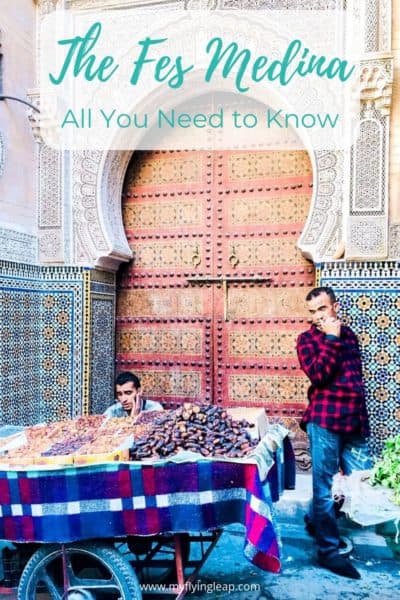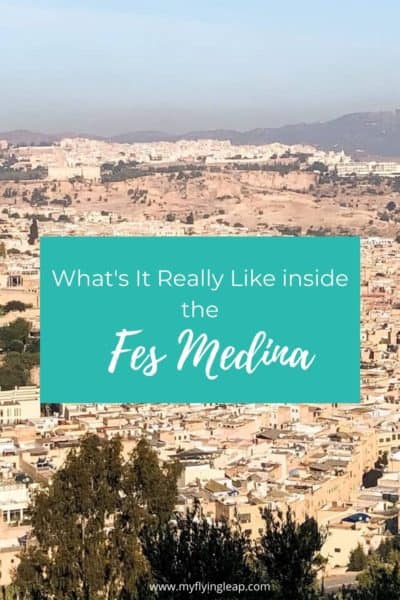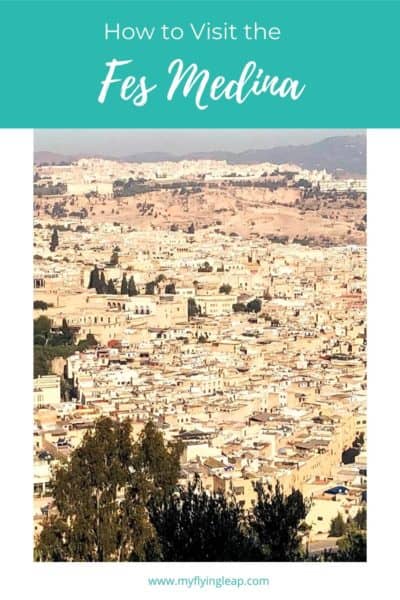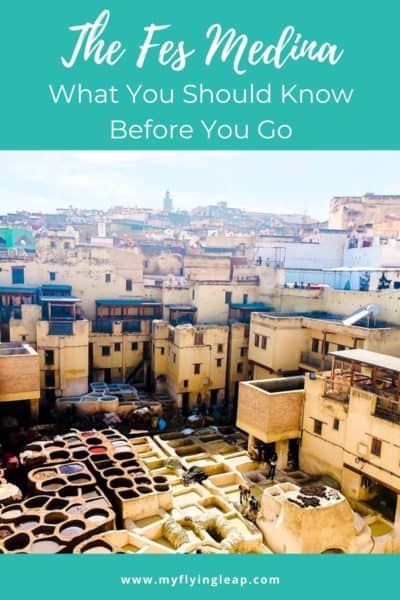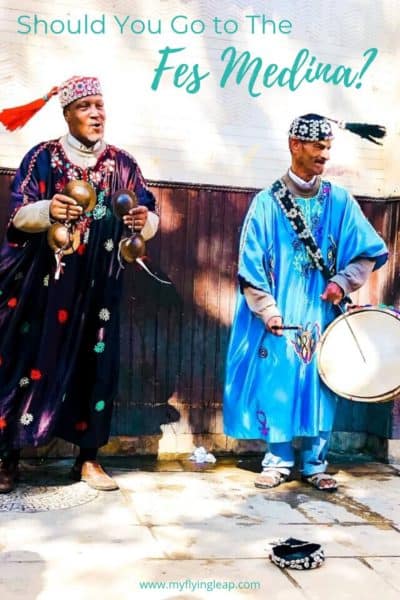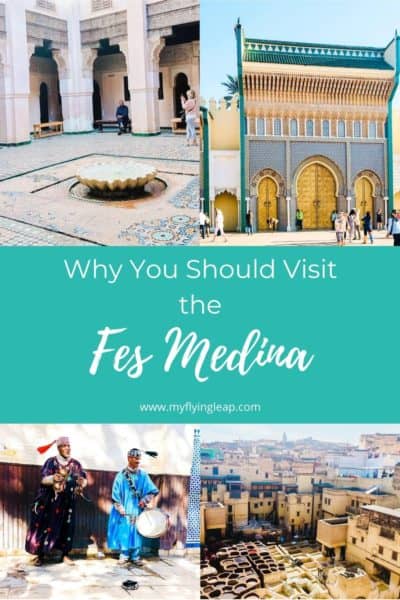What It’s Really Like in the Medina of Fes Medina
Wander through a labyrinth of narrow passageways that both charm and overwhelm. Your senses are on fire with the scent of fragrant herbs and spices, loud rhythmic music, and the sounds of commerce with many people in a tight space. This is life in the Medina of Fes.
This post includes everything you need to know to visit, including what to see and do, some options for eating, and what to look out for when you go. It’s an incredible place and worth seeing when you visit Morocco.
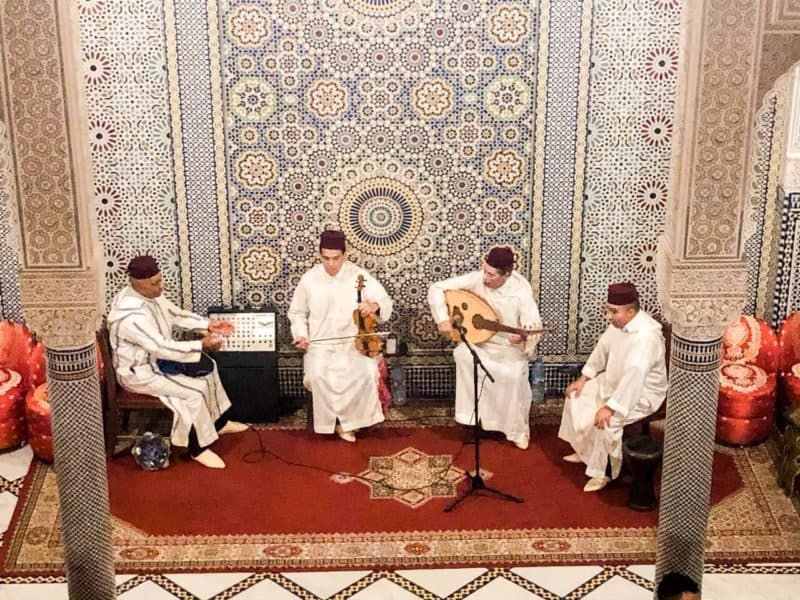
This post may contain affiliate links, which means I’ll receive a commission if you purchase through my links at no extra cost to you. Please read the full disclosure for more information.
The City of Fes
The city of Fes is an imperial city and the former capital of Morocco. Fes is the second-largest city in Morocco, second only to Casablanca, with 1.7 million people. It is located at the crossroads between Casablanca, Marrakech, Rabat, and Tangier.
Fes is home to the largest and the oldest medina (old walled city) in the country. It was built in the 9th century and is one of the best-preserved medinas in the country and possibly in the world. Around 90,000 people are believed to live there still.
In its heyday, Fez attracted scholars and philosophers, astronomers and theologians, mathematicians, and lawyers. Kings endowed mosques and madrasas (religious schools), and craftsmen built royalty houses and palaces. Merchants offered exotic wares from the silk roads and sub-Saharan trade routes.
Fez lost its influence at the beginning of the 19th century, and it remains a city whose cultural and spiritual lineage beguiles visitors. It is the world’s largest car-free urban area in the world. While there are still some rough pockets, government efforts to restore the city are showing results.
Orientation of the Fes Medina
Fes is comprised of the medina and Ville Nouvelle, or the new city, constructed during the French colonial era. The Fes medina consists of two old quarters, Fes el Bali and Fes Jdid.
Fes el Bali is the original city founded on both shores of the River of Fes. Fes el Jdid was founded to the west a few hundred years later. The Fes medina, or old walled city, is the largest and oldest medina in Morocco.
What I didn’t realize before going is that the Fes Medina IS the old city. It’s not only a place of commerce but a place where people live. Many people grow up in the medina and never see life outside the old city walls. And the medina is positively massive, stretching as far as the eye can see.
I’m still struggling with how to describe the Fes Medina. I’m not big on crowds, so I was prepared just to spend my time here and go without thinking much of it after leaving. However, I am strangely drawn to this intense city, jam-packed with its ancient walls.
It wasn’t as crowded as it was claustrophobic, as many of the paths were incredibly narrow. It is so tight that cars cannot drive in the Medina, and it’s one of the largest car-free urban areas in the world. You see a lot of donkey carts hauling everything from produce to lamps.
What It’s Like in the Fes Medina
There’s something charming to the rhythmic flow of the Fes medina, and I thought Fes is one of the best places to go in Morocco. People love it or hate it, and I surprised myself by loving it. It’s not for the faint of heart, though.
I highly recommend getting a guide so you can wander leisurely. Not only to be safe (or safer) from rampant pickpockets in many areas of the medina. Also, you could truly get lost forever, and that’s not much of an exaggeration.
The picture below is an example of one of the narrow passageways out. The entrance to the inside of the medina to get to this spot was not obvious at all. In fact, I didn’t even see it until our guide walked through.
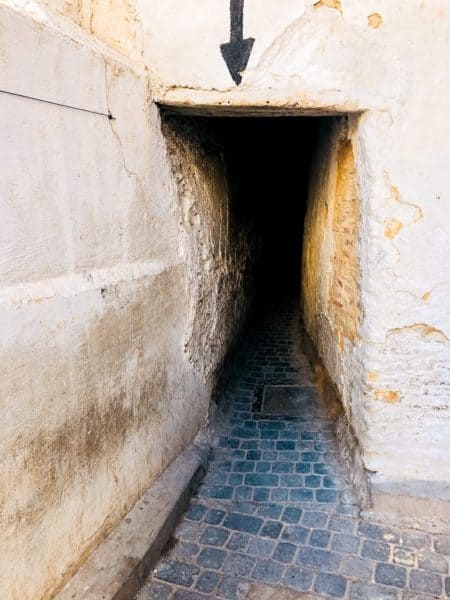
Balak, Balak!! Watch out! This was the phrase of the day while in the old medina. With so many narrow and winding corridors to walk through, there were constant carts and people carrying rugs and other large objects coming at us constantly.
We walked with our Fes city guide in the front and our group guide in the back for safety. You have to be very careful when in this area of the medina, and it’s a good idea for safety to have a guide.
The narrow paths are lined with aromatic food stalls and people selling every handicraft and souvenir imaginable. And it’s not all shopping as an incredible 90,000 people call the Fes medina their home. In fact, our guide lived there his entire life.
There are some rough pockets that you have to be very careful in, which is another reason to get a guide. Cautions aside, I was so intrigued by this place and highly recommend visiting. There are a lot of really interesting places to see inside this place of perpetual pandemonium.
You May Also Like 20 of the Best Tips for Morocco
Top Things to Do in (and Around) the Medina of Fes
As you might expect, there are a lot of incredible things to do in the Fes Medina. Finding your way around will be much easier (and safer!) with a guide.
1. Oldest University in the World – Al-Kairaouine Mosque
The University of Al-Karaouine, or the “university of the people” in Arabic, is located in Fes el Bali, the oldest part of the Fes Medina. It is the oldest continuously operating university in the world.
It was founded in 859 by Fatima al-Fihri along with a madrasa and became one of the top spiritual and educational centers of the Muslim world. In 1963, it joined the Moroccan state university system.
The university’s focus is on Islamic religious and legal sciences. Students come mostly from Morocco and Islamic West Africa, though some come from as far as Europe and Central Asia.
Students between the ages of 13 and 30 study at a high school level or a university level to achieve diplomas and degrees. Al-Kairaouine has been open to both men and women since the 1940s. The mosque is simply stunning.
The building is very large, though it doesn’t appear so because of being in the middle of so many buildings within the medina. It includes aspects of Moroccan and Islamic architecture.
It evolved over a thousand years, so it represents architectural styles from many different time periods. You’re able to walk through a portion of it, including a large and ornate courtyard and some of the old, very small dorm rooms.
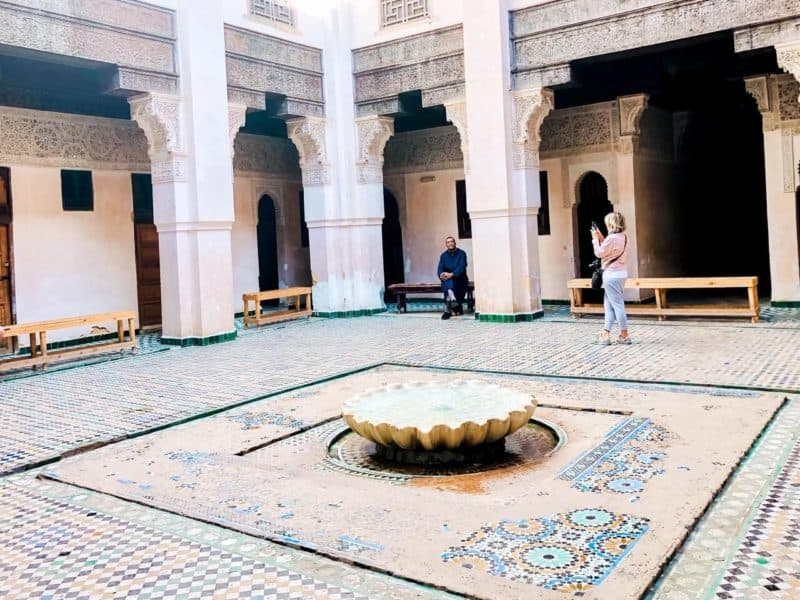
2. Chouara Leather Tannery
When we walked into the tannery, the first thing that happened was we were given a sprig of fresh mint. We very quickly learned what it was for! The smell in this place is intense!
It’s pretty amazing that the smell doesn’t seem to waft through the rest of the medina (or perhaps our noses grew accustomed to it!) It’s pungent and quite overpowering though not as bad with the mint. We huffed that mint sprig for the rest of our time in the tannery!
We climbed to the top of the building to look down at the pits below, colored by various natural minerals and plants to color the leather. They have to be incredibly strong to lift the heavy and wet large strips of leather to dip them into the pits.
It’s grueling, back-breaking work. And not only the physical labor of it, but they are front and center with that pungent smell due, in part, to the ammonia collected from pigeon droppings.
As if that couldn’t get worse, this is mixed with cow urine, quicklime, salt, and water to soften the leather. The workers labor year-round, though, in the heat of the summer, they do their work at night.
The process is lengthy to prepare a hide. They use sheep, goats, camels, cows, and lambs and first remove the hair. The hair is used to stuff cushions, so nothing goes to waste. Then, the hide sits for two weeks in pigeon waste, and they change it to “fresh” pigeon waste as well.
After it’s softened, the hide goes into a washing machine for 3 hours, where they use black salt and water to wash it. Then, the hide is dried on the roof for 23 days in the shade. Then it goes in a dryer for ten days and is ready to work.
You May Also Like 10 Incredible Reasons to Visit Morocco
Leather Showroom
Back inside, we walked through the showroom to see the end result, and the rainbow of colors was stunning. There was red from poppy, green from mint, yellow from saffron, aubergine from artichokes, blue from indigo, black from kohl, orange from henna, and brown from cedar wood or pomegranate skins.
The feel of the leather was like nothing I had ever felt before, and it felt absolutely soft and almost creamy. The quality is amazing, and the prices were surprisingly affordable given the manual-intense process.
A short jacket, for example, was 280 to 300 Euros ($300+ USD). They can take measurements and provide a custom coat (or other apparel) in as little as 5 to 7 hours.
They offered a wide range of items for purchase, from jackets, pants, and belts to shoes, bags, and souvenirs. And if you didn’t like the color of anything, they could make you a custom item.
The salesmen were fairly aggressive and some of the pushiest that I had seen in all of Morocco. I had read stories of them holding people almost hostage until they agreed to make a purchase, so I definitely advise some caution entering. But this is something you will want to see for sure, and I haven’t ever seen anything like it.
Chouara Tannery is the best-known of the three tanneries in Fes and is located in Fes el Bali.
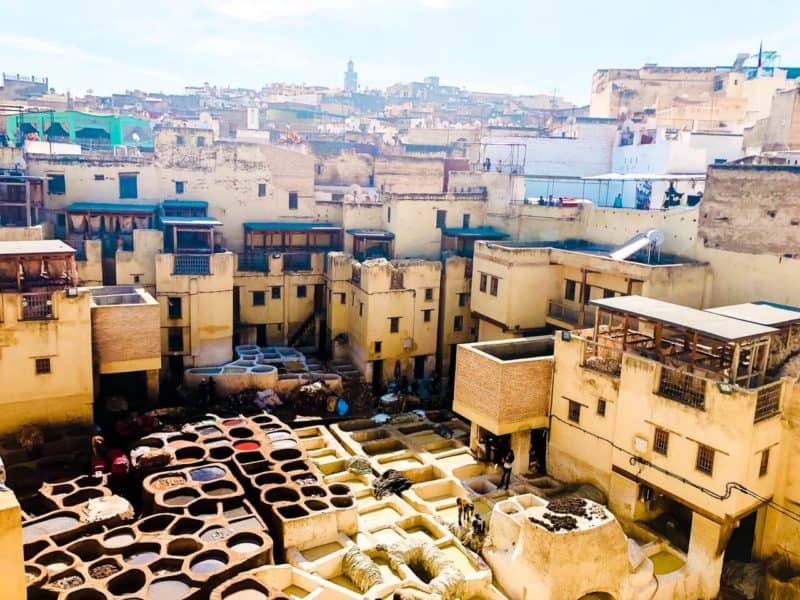
3. Textile Co-op
We also visited a loom co-op in Fel el Bali, not far from Chouara Tannery. They showed us their manual process on a large loom that was at least 10 feet across to make some of their largest tapestries and blankets.
They use a number of fibers to make their knits, though mostly wool, cotton, and silk from the agave plant. We had a chance to touch woven goods made from each of them to feel the difference. The silk was very different from the silk we generally know, and it’s often used as a mix with cotton to soften the item.
Most of us bought small scarves to be used to cover our heads while riding a dromedary in the desert as we were heading to Mergouza next. It’s a good idea to wear a head covering to help maintain your body temperature in the desert, both to protect yourself from the sun and to maintain heat.
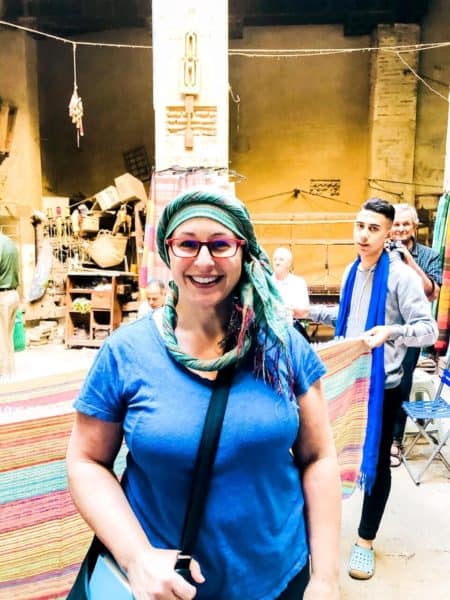
Fes Medina – Fes el Jdid
The newer part of the old Fes medina is called Fes el Jdid. This area is much more modern and spacious than the older section in Fes el Bali. The two could not be more different.
Where Fes el Bali is mostly covered, Fes el Jdid is open. Streets are wide, and I didn’t even realize it was part of the medina except for our guide pointing out portions of the old city walls.
4. South Castle
A high wall once completely surrounded the original old city of Fes, and it had seven golden gates that were the entry points to the city. The South Castle, up on a large hill, was one of the primary defense points protecting the city from invaders. Go up for the best view of the medina. It’s impressive!
5. The Jewish Quarter
The Mellah, or Jewish quarter, is in this area, dating to a time of the 14th century. At its height, 225k Jews lived in this Mellah, the largest Jewish population in all of Morocco.
The entryway was called the Door of Love, and you can still see part of it, along with a restored section of the old city wall. Just past it is a large Jewish cemetery.
Our guide told us the sad story of a young Jewish woman from Tangier who caught the eye of a Moroccan king around the end of the 19th century. He saw her and wanted to marry her, which was deemed to be acceptable since, as a Jew, she was of the “people of the book.”
She was told she had to convert and refused, so he killed her. She is buried in this cemetery, and it was a place that the Jews visited when they lived in this area.
The Transition
As with the Jews in other areas throughout Morocco, many moved here during the Spanish Inquisition, when it was unsafe for them in Spain and even in Portugal. Initially, they were expelled from those areas, but those who stayed, if they were caught, they were killed.
Many escaped to Morocco, where they lived peacefully for hundreds of years. In the 17th century, there was an exodus from the Mellah. Then, in 1948, when the State of Israel was formed, most of the Jews in Morocco moved out to Israel, leaving their homes behind.
When they left, Arabic people moved into their homes. It was inhabited by a very poor class of people and passed down through generations. They had no papers of ownership, and apparently, if the original owners, or at this point, the descendants of the original owners, come back with a deed, they can take ownership of the home again.
Given how the area has deteriorated, though, that’s unlikely. This part of the city is dangerous at night, so most don’t want to go there.
There were some truly stunning buildings of Arabic and European construction, and some that looked like bulldozing them would be the kind thing to do to put them out of their misery.
In that area, it appeared to be pedestrian-only, and the pathways were narrow, much like in Fes el Bali. The Mellah is very old as well, and sadly, when the Jews moved out, it fell into ruin.
6. Royal Palace
The Royal Palace is in Fes el Jdid, right near the Mellah and near a segment of the old wall that was restored by UNESCO. It’s the oldest Royal Palace, built in the 14th century, in the country, and the outside is stunning.
The king actually does visit and live here for parts of the year, but he was not here when we were (as evidenced by the lack of guards and military police).
There were a lot of people visiting (as you can see!) and it’s a popular place for tourists. Off to the side of the building, there was a door with guards, indicating that there was an important visitor staying there. We were told not to take pictures of that area to ensure the privacy of the guests.
Unfortunately, there are no tours of the Royal Palace, much like the other residences of the king. So, you have to imagine how incredibly beautiful the inside of the palace must be, given how stunning the outside is.

7. Pottery Co-Op
Fes is a city of artisans, and there are many similar pottery co-ops sprinkled around the city. We went to Mosaic et Poterie Co-Op, where everything was done in the old ways by hand.
It was an impressive place and quite expensive, but worth seeing. And they made sure we knew that they ship anywhere in the world. If you want something that is top quality for your home or for a gift, this is definitely a good place to go.
Making the mud is a laborious job when it’s done by hand. First, they mix it with water, and rose water is what this place uses. After mixing for a week, they mix the mud further with their feet.
Then, they throw it on a pottery wheel to shape the piece. Next, it is dried in an oven or kiln. Then they paint and glaze it, using a glass powder so it can be used for cooking. Then, they cook for the last time in the kiln.
You will see a large range in the quality of items being sold in the markets. Some are top quality and, of course, the highest price, like what you will see in the co-ops around the city. Others range from there, and you can tell in the quality of the painting, the finishing, the cutting, and the pottery itself.
The Pottery Artisans
First, we watched a man on a pottery wheel and learned about clay. There are three kinds found in Morocco: red, white, and grey.
The red clay is used to make bricks, and it was used to build many of the original parts of Marrakech, known as the Red City. Grey is mostly what is used for mosaics as it is the most durable.
We got to watch the entire process done by hand. The painters were lined up at desks hunched over their work, clearly used to being watched. They used horsehair brushes that they cut themselves to their preferred width for the piece they were working on and worked with such meticulous care.
We learned that some of the colors dry differently, so the purple paint color becomes blue with heat. Their paints are all natural and made with minerals.
One of the most interesting parts of this, and unnerving, were the men cutting mosaics. They do it by hand with incredibly sharp tools, and it’s a risky profession, especially as you’re learning.
They apprentice for 5 to 7 years to learn how to do this, and they are required to take breaks every hour, given the intensity of the work.
The tile cutters get paid by the piece. Some cut the tiles into intricate shapes while others lay them out in mosaic patterns. When preparing the mosaics, they place the tiles upside down.


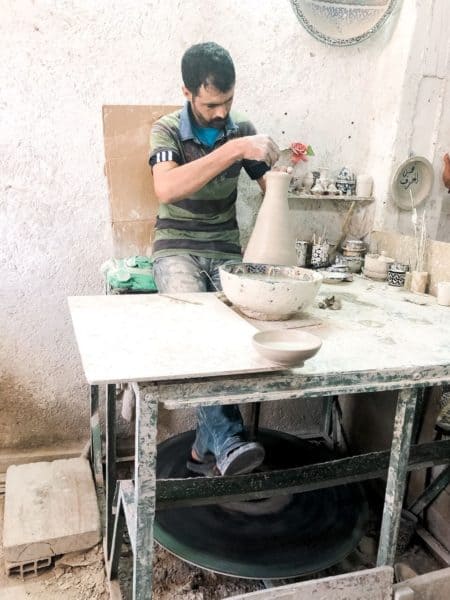
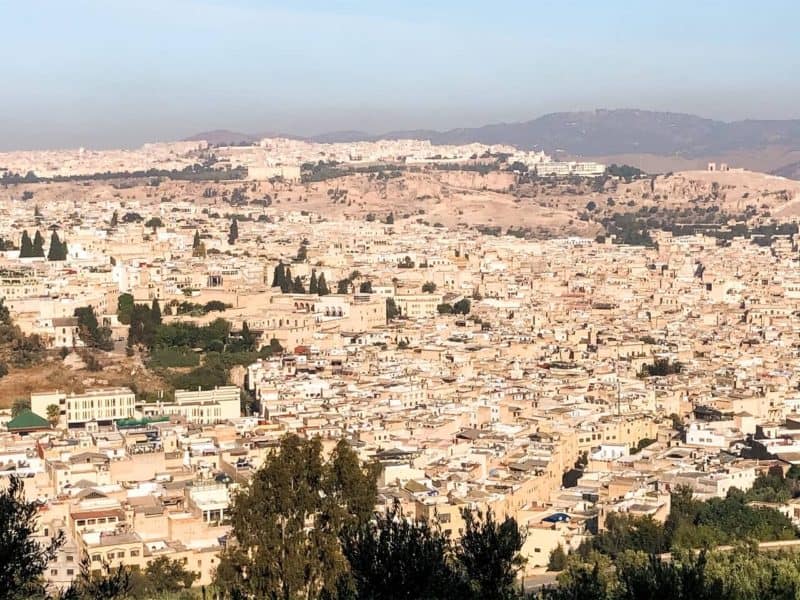
Day Trips from Fes
Fes is a great place to explore, and there are several great day trips you can take if you’d like to see a little more of the area. Two that I recommend are Volubilis and Meknes. In fact, you can do both in one day, depending on how much time you want to spend on each.
Volubilis
Volubilis is a top place to visit in Morocco, and it’s one of the best-preserved Roman ruins in the world. It is located between Meknes and Fes and was founded in the 3rd century B.C. by local Berbers.
The Romans took control of Volubilis in 146 B.C., and in 24 B.C., it became the capital of the Roman state, Mauritania. Around 20,000 people were believed to have lived there, and it was a wealthy and important city.
However, local tribes caused issues, and the inhabitants started pressuring Rome for status and financial concessions, leading Rome to abandon the settlement in 285 A.D.
It remained inhabited for 700 years, first by Christians and then by Muslims who moved into the area in the 8th century. It was later abandoned in the 11th century when Fes became the seat of power for the area.
The Roman ruins of Volubilis were destroyed by the Lisbon earthquake of 1755. Rulers from the city of Meknes used some of the stone to build that city when it rose to power to become an Imperial City.
After that time, Volubilis was all but forgotten until the French found the ruins in the late 19th century when Morocco fell under French rule. Around half of the site was excavated, and Volubilis became a UNESCO World Heritage Site.
You May Also Like Why You Should Visit the Roman Ruins of Morocco
Tour Volubilis Today
You can tour the archaeological site of Volubilis now and walk among the ruins to tour the city that once was. Walk through the Arch of Caracalla, the main gate into the city, onto the main road, Decumanus Maximus.
See the basilica, one of only two built in the area, and the Temple of Jupiter, where important plans were announced. See an ancient thermal bath and view some amazing mosaic floors from some of the wealthiest people’s homes.
It takes some creativity, but you can see what a thriving city this once was, surrounded by the olive groves that made it wealthy.
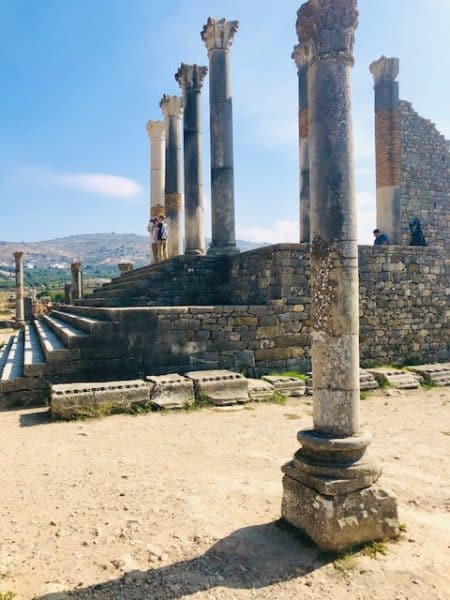
Meknes
Meknes is one of the four Imperial Cities of Morocco. It was founded in the 11th century and became the capital of the country during the late 1600s and early 1700s. Though it no longer has such a place of importance, it is still the sixth-largest city in Morocco.
Meknes has a distinct Spanish-Morrish style. It’s best known for its large, ornate gates that are the entrances to the old city.
You can easily get a taste of the historical importance of the city with its towering old city walls, the gates, and the many large and ornate buildings. In fact, the historic city of Meknes is a UNESCO World Heritage site.
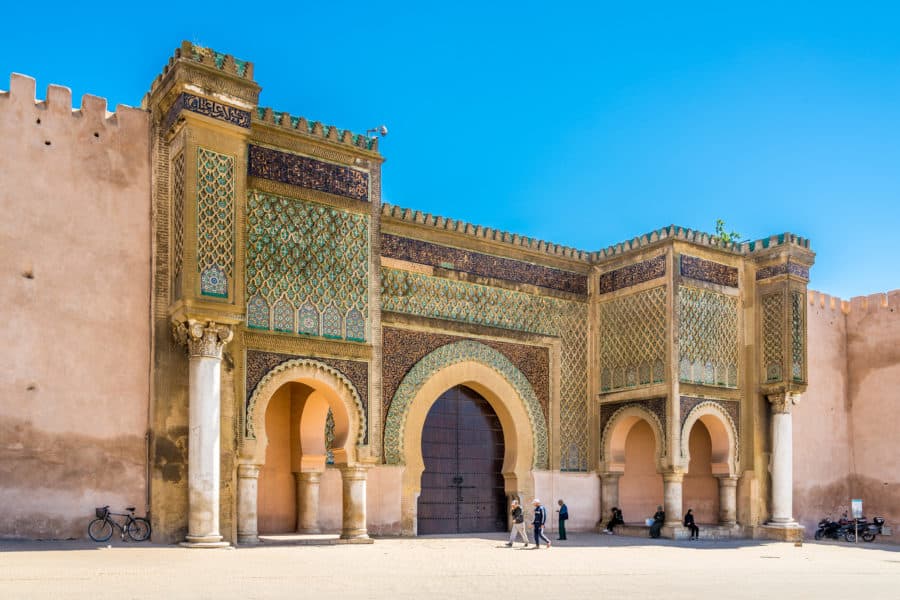
Tour the royal stables, where a massive 12,000 horses were kept. The building is a feat of engineering with a high ceiling and angled openings to give a view well into the distance of the horses and those who tended to them.
See the royal granary, built so large to withstand a siege of nearly twenty years to provide for the horses. The building is simply massive, and the walls are incredibly thick to maintain cool enough temperatures for long-term food storage.
It is now a ruin as the roof caved in during the 1755 Lisbon earthquake. Even still, you can see how massive this building once was and can marvel at the architecture.
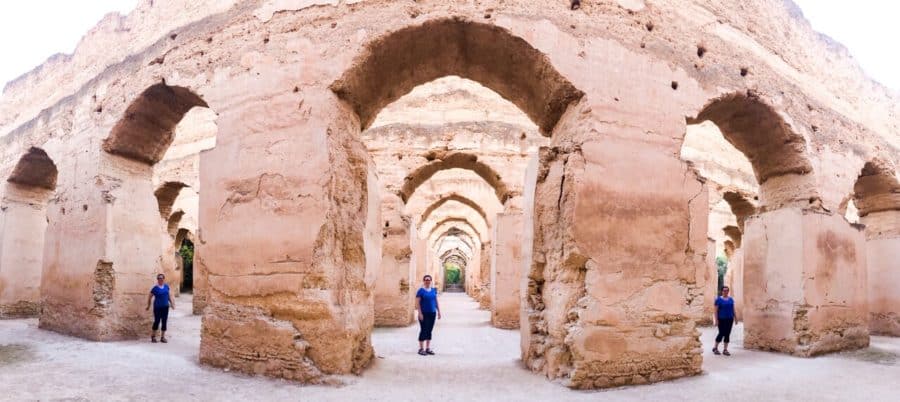
Next to the royal stables is Sahrij Swani, a man-made lake built to ensure water for the city and the horses. You can also tour the many ornate gates to the city, including Bab Mansour, across the street from El Hedim Square, the large marketplace in the city.
It’s a good size but smaller than Marrakech’s Jemaa El-Fnaa and is often called a miniature version. Wander through the narrow streets of the medina to see what life is like in this smaller city and admire the differences in architecture that you see here.
Where to Eat in Fes
We sure packed a lot into visiting Fes in just one day! It was overwhelming and, at times, overpowering, but truly such an amazing experience.
We ate at a restaurant in Fes el Bali, but unfortunately, I didn’t note the name of it. It may have been Restaurant Dar Tagine, which has great reviews on TripAdvisor and is known as a local favorite. It was after visiting the tannery, and I think we were all a bit overcome by the fumes!
Restaurant dar Tagine is located at Derb Elghorba 71, Ancienne Medina, Fes 30000, Morocco.
We ate dinner at a great place near our hotel called Restaurant Marrakech. We were on a quest to try the famed pastilla, an interesting sweet and savory dish made of ground chicken and spices inside phyllo dough.
It was delicious and very similar to what I had once in the United States. We also got some skewers as we had “tagine fatigue” during this part of the trip (which was pretty early on!)
Restaurant Marrakech is located at 59 Avenue Mohammed Zerktouni, Fès 30050, Morocco.
It was served with a grand flourish by who may have been the restaurant owner, with sweet tea poured from an incredible height into our glasses. Quite impressive! He only spoke French but was very friendly and helpful.
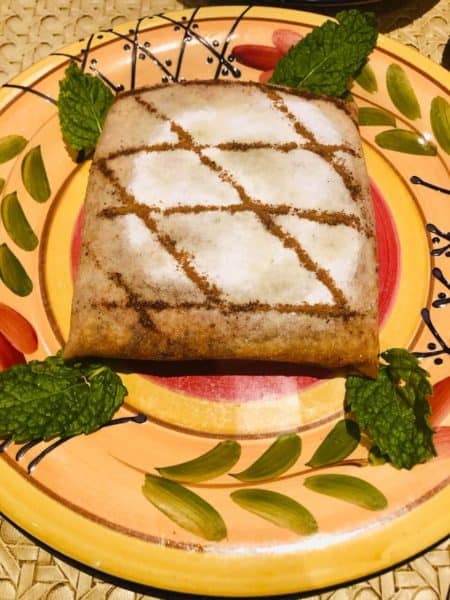
Where to Stay in Fes
We stayed at Hotel Mounia Fes. I thought it was a great hotel and one of the nicest that we stayed in during the trip. The rooms were small but comfortable, and they even came with a sticker pointing us in the right direction to Mecca.
The bed was the most comfortable I felt in Morocco as well. Restaurant Marrakech is just down the street, around a two-minute walk away. There are also small shops and a laundry place just a couple of minutes away, so it’s a convenient location.
Hotel Mounia Fes is located at 60 Rue Mohammed Zerktouni, Fes 30050, Morocco.
Moroccan Massage and Hammam
They do offer amenities in this hotel, much like most, and my friend and I decided to get a massage. I got a 30-minute massage, which cost $200 MAD (around $20 USD).
It was my first massage in Morocco, and I wasn’t sure what to expect, but it certainly wasn’t what I got! For a country where the women often dress so modestly, the massage was anything but.
I was given a small paper thong, and she indicated that I should lay face-down on top of the blanket. I got a hot-stone massage by the time she indicated that I should roll over on my back, I pretty much had thrown any modesty out the window and didn’t care.
She rubbed almost every part of me, including my breasts and stomach. It was very different from other massages I have had, but it was pleasant and worth the experience.
The hotel also has a hammam, with a large steam room. We decided not to use it. However, I found it interesting that people in bathrobes walked through the lobby from the steam room to the massage room.
I did get a Moroccan Hammam at a place in Marrakech, though, and it was a really fun (and only slightly painful) experience. Having said that, I highly recommend trying a Moroccan Hammam, and yes, I would do it again.
You May Also Like All You Need to Know About a Moroccan Hammam
Other Hotel Options
If you want to stay right in the Fes Medina in a riad, Dar Fes Medina is a good option. It’s located at 3 Lot Benjelloun Ziat Medina, Derb Mokri, Fès 30110, Morocco.
Riad-Boutique Borj Dhab Fez is another option in the Fes Media, only a few minutes’ walk from Restaurant dar Tagine. It’s a beautiful boutique riad located at Derb Borj Dhab, R”cif, Fes 30200 Morocco.
How to Get to Fes
Fes is easy to get to both internationally and from other cities in Morocco. You can get there by plane, train, bus, and car.
Fes Airport
Fes-Saiss Airport (FEZ) is located around 10 miles from the center of Fes. There are regular flights there from the major cities in Europe, so it’s easy to get to.
If you’re taking public transportation, the number 16 bus will take you into Fes (around 4 MAD), or a taxi will take you (around 150 MAD).
Fes Train Station
The Fes train station is Fès-Ville. There are regular trains from the other main Moroccan cities, including Marrakech, Tangier, and Casablanca.
You usually don’t need to book in advance as there are frequent trains running. Though, you can book online if you choose to on the ONCF website.
Bus
The main bus terminal is at Gare Routière in the north of the old city. It has extensive connections to other Moroccan cities.
Car
You can take a car to Fes as well, though keep in mind much of the old media is car-free. The A2 road connects Casablanca and Rabat with Fes.
Fes Weather
Fes is located near the Atlas Mountains. It has hot summers and cool, wet winters with rain but generally little snow. The best times to visit are generally between September and November and March and July.
Summers from June to September can hit highs in the mid-90s F (30s C). In the winter, temperatures are usually around a high in the mid-to-upper 50s F (mid-teens C).
Are You Up for Visiting the Medina of Fes?
Fes is an intense and magical place worth visiting when you go to Morocco. In fact, I would ask, if you don’t see Fes, did you really even see Morocco at all? Be prepared to be overwhelmed in the old medina as it somehow manages to work its way into your heart.
You Might Also Like
- 10 Incredible Reasons to Visit Morocco
- Traveler’s Guide to the 11 Best Places to Visit in Morocco
- 20 Best Travel Tips for Morocco
- G Adventures Morocco: Kasbahs and Desert Tour Review
- Why You Should Visit the Roman Ruins in Morocco
- The Best Things to do in Casablanca in One Day
- Why You Should Visit the Sahara Sand Dunes of Merzouga
- Marrakech to Merzouga: What to See Along the Way
- 11 Reasons Why You Should Visit Marrakech
- Top 9 Things to do in Essaouira
- All You Need to Know About a Moroccan Hammam
Like it? Pin it!
